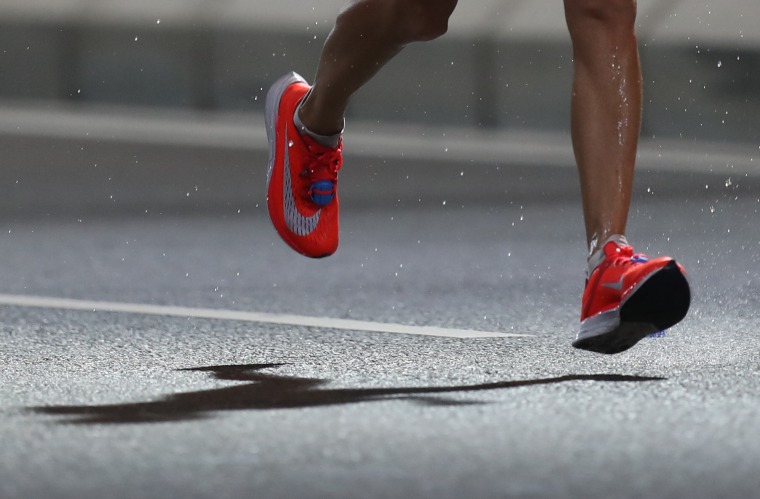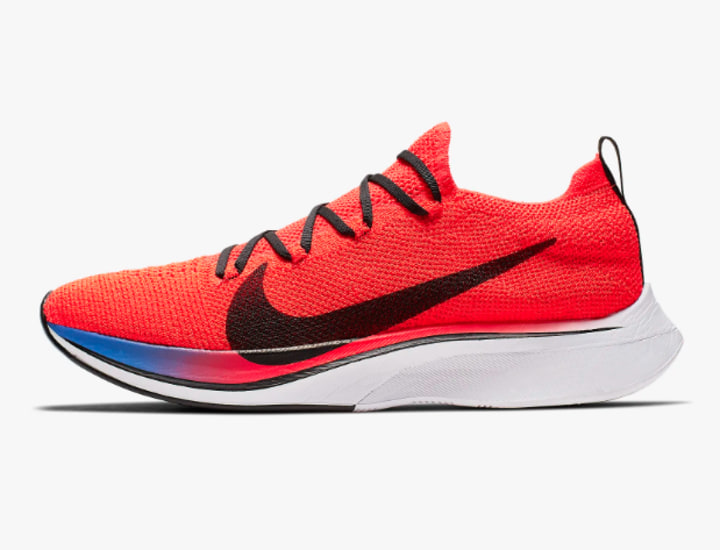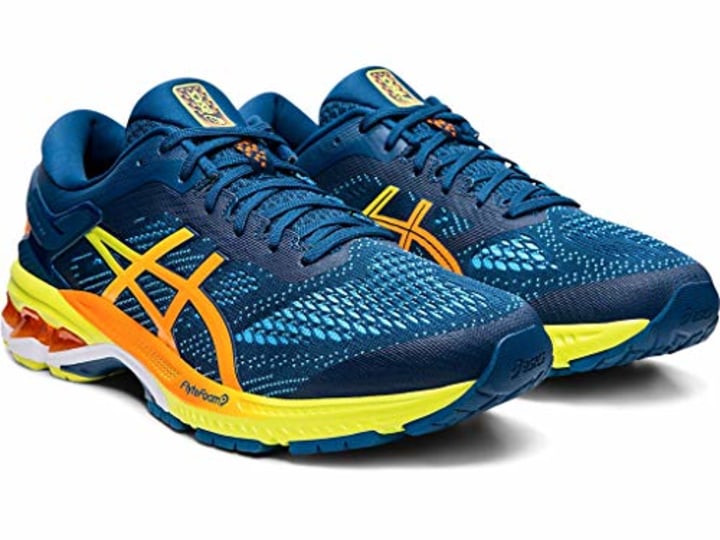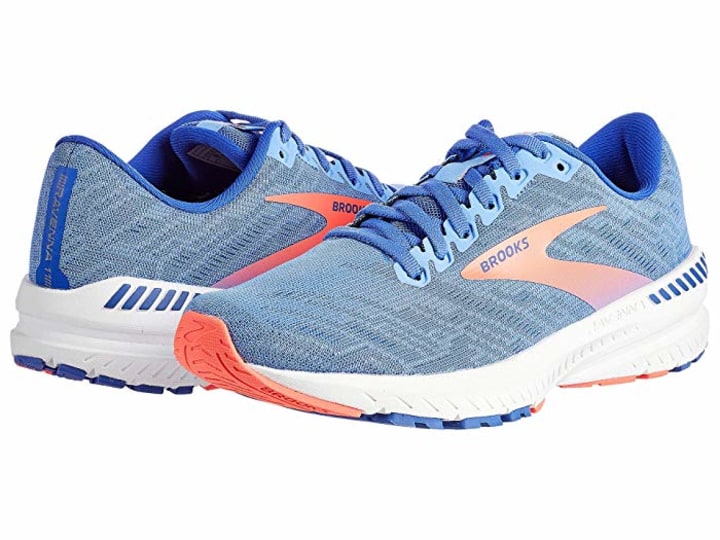I first paid attention to the Nike Vaporfly 4% Flyknit shoes when marathoners Geoffrey Kamworor and Eliud Kipchoge wore them and won the 2019 New York City Marathon — the shoes' name refers to Nike's claim they can boost speed by up to four percent. I’ve been recommending fitness products and exercises for years, from what trainers keep in their gym bags to the most common running mistakes, so I keep an eye out for cases like these. And the Vaporflys' exceptional construction — and controversial nature — have kept them in the spotlight since. In fact, 31 of the 36 top finishers at the six biggest 2019 marathons in the world wore Vaporflys, NBC News reported last week.
- Are the Nike Vaporfly 4% Flyknit shoes fit for you?
- Nikes ZoomX foam technology
- Vaporfly Flyknit's carbon-filled midsole
- Nike’s VaporWeave technology
- Should I buy the Vaporfly Flyknits?
The Vaporfly Flyknits are so seemingly effective that international track and field governing body World Athletics considered banning them from certain competitions. The recent deliberation came following a months-long investigation into whether Vaporflys violated a rule dictating shoes used in races must be "reasonably available" to all runners and cannot provide "any unfair assistance or advantage.” Ultimately, the Vaporflys avoided a global ban when World Athletics ruled Jan. 31 to allow them, but not without noting “concerns” that recent shoe technology poses a threat to “the integrity of the sport.”
“Friday's international ruling means athletes will be allowed to race in Vaporflys at this year’s Summer Olympics,” NBC News reported. “However, the new rules also effectively tamped down any hope that competitive brands could offer their own design for the Olympic Games.” (NBC News will be broadcasting the Summer Olympics from Tokyo.) Nike — which calls the Vaporflys "the fastest shoe we've ever made” — disagrees that they provide an unfair advantage. Regardless, the technology in the shoes might be worth a closer look.
Are the Nike Vaporfly 4% Flyknit shoes fit for you?
I asked podiatrist Dr. Velimir Petkov, DMP, what he made of the shoes. He works with patients — runners among them — who’ve specifically asked him to assess the Vaporflys. He first came across the shoes when a "running enthusiast in his mid-30s" brought them in, seeking an "honest opinion about them," Petkov tells me. He finds the shoe is great for distance runners for several reasons and noted a few concerns he thinks are important to keep in mind.
Nike Vaporfly 4% Flyknit Running Shoes
For one thing, Petkov says, the shoes could be a good option for larger feet.
“I like the wider toe area, which allows for better comfort in people with wider feet," Petkov says. "It also allows extra room for natural swelling of the feet, which usually occurs during prolonged periods of exercise or running. It’s a big plus for runners who engage in half and full marathons.”
Nike's ZoomX foam technology
The sole of the shoe differentiates it from alternatives with some proprietary Nike technologies. One of them is a responsive foam in the sole that's designed to return energy to your bounce. Nike calls this technology ZoomX.
"The ZoomX foam in the midsole is great for shock absorption," Petkov says. "The fact that this particular foam is able to compress more consistently than EVA midsole foams is excellent."
Vaporfly Flyknit's carbon-filled midsole
The second notable technology in the sole is a carbon-fill plate to help give you the feeling of getting propelled forward with each step.
"I love the full-length carbon fiber plate in the midsole. It provides more stability during the propulsive stage of the gait," Petkov explains. "Carbon fiber is feather-light. It is engineered for repeated impact due to the fact that it is lightweight, thin, and breathable."
Nike’s VaporWeave technology
The shoe’s material on top, VaporWeave, almost looks sheer — it’s paper thin, breathable, absorbs less water, and lowers the weight of the shoe, which helps with speed (remember that "4%" in the Vaporfly's name).
"I am also happy to see the VaporWeave engineered woven mesh, which helps with additional perspiration and less water retention, especially in long-distance runs," Petkov says. "You want a pair of shoes using fabrics that allow water vapor to escape."
Should I buy the Vaporfly Flyknits?
Avid runners will likely get the most out of this shoe. If you're sticking to paved roads, treadmills, and flatter surfaces, the shoe is really designed for your type of running — especially if you've been looking to up beat a personal record or slowly hasten your pace. (If you’re a beginner and curious, try these shoes out. I recommend that my private clients arm themselves with the best gear in order to get in the best workout.) If you’re a walker, you’ll feel like you’re walking on a bouncy surface that’s propelling you forward, which can increase your walking speed and help get your heart rate up faster than otherwise.
If you're running off-road or during a hike, these may not be the best option.
"My main area of concern looking at the Nike Vaporflys is stability," Petkov advises. "I would not recommend these shoes for uneven surfaces or marathons with many sharp turns. That could lead to ankle twists and sprains."
If you're looking for more affordable running shoes, you can likely find them and may not need the exceptional features of the Vaporflys. Petkov admits he’s "not a big fan of the hefty price tag."
"There are other specialized brands (ASICS, Brooks) which may offer similar features at a lower cost," Petkov says. "It would also be nicer to see a wider color range."
Nike Vaporfly Flyknit alternatives
ASICS GEL-Kayano 26 SP Running Shoes
The highly-rated GEL-Kayanos are built with a mesh upper for breathability, EVA sockliner, GEL cushioning in the front and back of the foot and the brand's proprietary FLYTEFOAM, a lightweight build designed to propel your steps.
Brooks Ravenna 11 Running Shoes
These new shoes from Brooks are designed to lower the chances of injury with focus on the knees. The brand's GuideRails design helps keep excess movement in check and lightweight cushioning in the midsole is aimed at delivering extra rebound.
Catch up on Select's in-depth coverage of personal finance, tech and tools, wellness and more, and follow us on Facebook, Instagram and Twitter to stay up to date.






